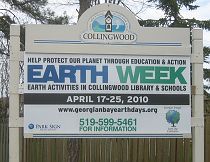Archive for July, 2011
Summer Readings for 2011 Take Us to New Heights for Inspiration and Action
“There is no such thing as a green pepper… All peppers start out some shade of green (either dark, light or yellowish) and gradually turn red, yellow, orange or even purple as they mature and sweeten. A green pepper, like a green tomato, is simply unripe.” Patrick Lima and John Scanlan’s “The Organic Home Gardener”
“Nature loves man, beetles, and birds with the same love.” John Muir
“We have done deeds of charity, made peace of enmity, fair love of hate, between these swelling wrong-incensed peers.” Shakespeare’s Richard the Third
Patrick Lima and John Scanlan’s just released second printing of “The Organic Home Garden” is joyously required reading for anyone who loves to garden. These Bruce Peninsula heroes of soil, seeds and thirty plus years of creative sweat have toiled to create the perfect book for both beginners and callused-handed inveterate gardeners. “The Organic Home Garden” is far more than a ’how to’ book. Yes, we learn about the proper care of raising many vegetables but also find inspiration in the photos and finely crafted words of these two men. The authors’ passion can not but strike a chord of reverence for the Earth. Patrick Lima’s quiet prose conjures up all that is beautiful in the garden. “…it is a pleasure to potter in the tomato bed, pushing in stakes, plucking suckers, tying the hairy stems with strips of old bed sheets, watching the fruit swell from week to week, then blush pink and finally redden.” And the many subject headings draw in the reader: “Of Suckers and Stakes”, Bugs, Cracks and Cat-facing”, “In the Trenches”, “Of Mulch, Maggots and Mold” and “Midsummer Miscellany” are just a few intriguing titles that make us want to read more. From the care of herbs to the potato and great cooking recipes, there is cause to celebrate the new edition of this Canadian classic. Without a doubt, a summer visit to ‘Larkwhistle’ will inspire you to be a better gardener and cherish these organic gardeners’ wisdom. Don’t wait till you are reading their book in bed on a cold winter’s night dreaming of new sowings of shallots and spinach; visit ‘Larkwhistle now and buy it there. Call 519 795-7763 for directions and hours to visit.
When is the last time you read Shakespeare’s “Richard the Third”? Although Stratford is a two hour journey, every year I find myself dusting off a play of Shakespeare’s and recall the prose and poetry of Elizabethan England’s fantastic vistas of the sublime and the treacherous: “Richard the Third” offers us both. Although we may wish to see Richard’s demise, what brought him to such murderous actions reverberates in today’s political theatres. Civil wars, greed, loyalty and love for ones kin can’t help making this play a ‘hit’ with audiences since 1593. I have never seen a play at Stratford with a stronger cast. It’s not only Seana McKenna, who brilliantly shines as the female- playing Richard but every actor is powerfully played. The stage craft is superb. Miles Potter’s direction of the play is creative and sensitive.
Donald Worster’s “A Passion for Nature: the Life of John Muir” should be on every nature lovers book shelf. Many of us know that the Sierra Club’s first president was John Muir and indeed a resident of Meaford for a year and a half, but few of us know how John’s religious upbringing was transformed into a powerful voice for Nature. Throughout this 466 page biography John Muir, the man, is portrayed first and foremost as a quiet advocate of people’s right to experience nature but never to overrule or abuse her. Muir’s adventures in the Sierra Mountains or in Alaska can be found here and in his short essays and articles. .Although he was a very reluctant spokesperson for conservation, his powerful and unadorned authentic passion for wilderness won over all segments of society, leading to the establishment of the world’s first national parks. Just as importantly, we learn about those people who shared his conservation goals, including the wonderful women in his life. Worster sums up John’s contributions this way: “The ultimate destination of the conservation …movement that Muir helped found is to transform the United States and other nations into “green” societies where pollution and waste of natural resources will have diminished significantly, where nature will become more than a ruthlessly exploited or even prudently managed “economic resource”. Nature will be granted a higher emotional, spiritual, and aesthetic value- a value in itself. No one in the nineteenth century America was more important than Muir in persuading people to move toward such a vision.”
World Population Day makes us Reflect on Sane and Compassionate Actions
“As things are today, even without any further increases in world population, if every person in the world were to start consuming as Americans {Canadians} do, humanity would require the resources of at least two additional planet Earths to support it.” Paul and Anne Ehrlich
World Population Day (July 11), created after the world had 5 billion people in 1987, and integrated with other world initiatives, celebrates, educates and finds solutions for a growing population and our planet’s health. World Population Day 2011’s theme is Calling Attention to Urgent Global Issues: young people, women and girls, poverty reduction, reproductive health, environment, ageing populations and urbanization. Consider: the planet had a billion people around the time of industrialization and rose to 2 billion by 1930 and then tripled to six billion in 2000. In a recent June article called “Climate, Food and Population”, I mentioned the U.N’s estimate of 10.1 billion people living at the beginning of the 22nd century. This number may be quite charitable, as the population may rise to thirteen billion people. Regardless of these numbers, scientists have clearly linked the extreme risks of a rising population, an increasingly unstable climate with food affordability and availability. We have become so inventive that our cultures can be seen from space, and most vividly at night!
Please take a look at these recent photos from the International Space Station showing how the web of night lighting is indicative of an increasing population pushing its way into every part of the globe. We see in the first photo how the entire length of Earth’s longest river, the Nile, is lit up. Paul and Anne Ehrlich’s book “One with Nineveh: Politics, Consumption, and the Human Future” has a composite photo of the world at night. It is ablaze with lights. Seven years after these scientists’ book was published, the world’s population has gone from 6.3 billion people to seven billion by October, 2011. When Professor Ehrlich wrote his controversial book, “The Population Bomb” in the 1968, governments thought the present day inheritor of Malthus’18th century theory of human population growth had really made a massive mistake. Malthus said,” “The power of population is indefinitely greater than the power in the earth to produce subsistence for man”. Tragically, the Ehrlich’s predictions for human survival are now repeatedly confirmed. The ‘Malthusian Catastrophe’ is fueled by super-exponential growth, and greed I might add.
Although the question of ‘population’ is politically taboo, both ‘left’ and ‘right’ journalism have recognized the urgency to address the ‘population question’. For example, The Economist has run a series of in-depth articles on the “The Anthropocene”. (Most scientists now have concluded that we have changed the Earth to such a degree, it’s necessary to call the epoch for the 21st century and beyond, the Age of Humans: the Anthropocene. Bill McKibbon’s 2010 book is called “Eaarth”, signaling that the Earth needs a new name in light of human made changes.). A New York Times article by Justin Gillis starts:” The great agricultural system that feeds the human race is in trouble.” The title for the article is “Food for a Warming Planet: scientists raise alarm at prices, population and heat”
Compassion for the great suffering of a billion people should hold no political stripes, but too often it does. In 2009 the G20 group of nations, at a gathering in Pittsburgh, set up the Global Agriculture and Food Security Program (GAFSP) to allow poor nations to regain stability, access to markets and perhaps most importantly, local resilience in the face of soaring prices for food. By far, Canada has given more money -$224 million- than any other nation towards this program. And as this article is being read, Somali climate refugees are pouring into Dadaab camp in Kenya, with now 354,921 plus people, to escape drought-stricken areas.
Since Canadians, Australians and Americans ‘lead’ the world in the rapacious destruction of the planet, vast relief would come with a one child policy for these nations to help curtail the world’s misery. As well, compassionate adults should create the means for the stricken children of other nations to thrive by drastically lowering their consumption and becoming vegans (a vegan’s food/ecological footprint is so much lower than a meat/dairy eater’s). Grandparents and parents might also sing the praises for adoption of the malnourished living rather than pushing 20th century models of ‘family’. Vast revenues can be found as well by stopping medical research that only benefits the rich few (us), and channeling that money into disbursing known medical successes to the three billion humans who, for example, lack the simple remedies for water born diseases. Doing more and taking less can revitalize our society and the Eaarth.

